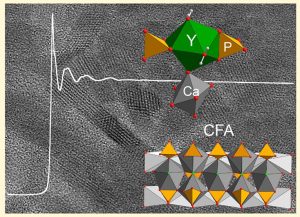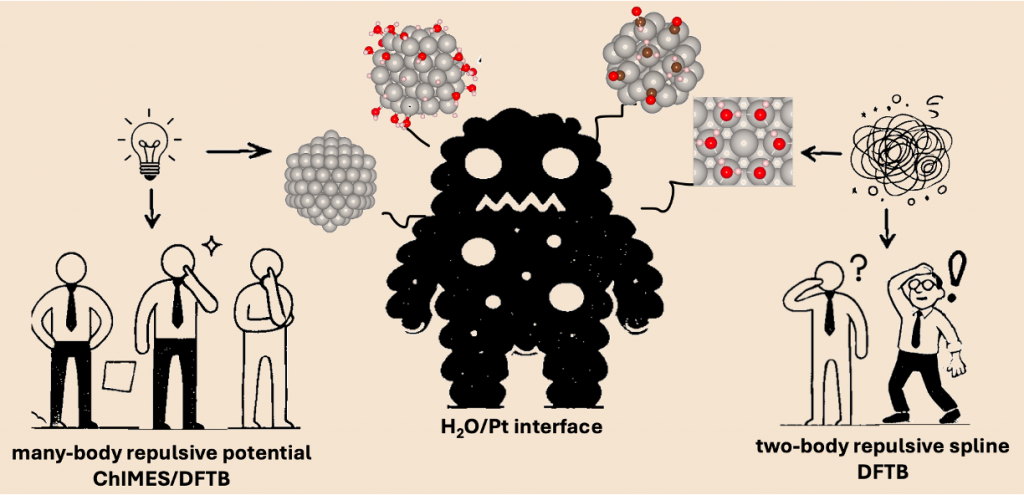 CNRS Researcher
CNRS Researcher
Laboratoire de Chimie
ENS de Lyon, France
Main interests:
Modelling Solid/Liquid Interfaces
Developping Tools for Cluster Expansions
Improving the Description of Charged Surfaces
 CNRS Researcher
CNRS Researcher
Laboratoire de Chimie
ENS de Lyon, France
Modelling Solid/Liquid Interfaces
Developping Tools for Cluster Expansions
Improving the Description of Charged Surfaces
Having figured out where is Cerium, we wanted to know if Yttrium, which is much more abundant in fluoroapatite, is co-located with it or not. In our latest research on lanthanides in fluoroapatite, published in Chemistry of Materials, we demonstrate that Y is not in the same chemical environment as Ce. There are no Y aggregates detectable by EXAFS. Instead, Y seems to be incorporated in the amorphous coating of the apatite crystals.

Mohammed Bin Jassar has done a great job in writing a perspective on the use of kinetic Monte Carlo in the context of batteries. I am very happy to announce that it has finally been published in EES Batteries. We extensively discuss the challenges to achieve more reliable insights while keeping an atomistic or at least molecular resolution.
Discover the location and chemical nature of cerium in Rare Earth element rich bio-apatites in marine sediments in our publication in Communications Earth & Environment. In this article in strong collaboration with Alain Manceau (ERC DEEP-SEE), we finally publish the story of cerium in (or we should rather say on) biogenic apatite. Indeed, detailed experiments conclusively demonstrate that cerium is not inside the apatite structure, but forms phosphate precipitates on the nano-apatite crystals.
In the context of the productive collaboration with Alain Manceau and financed by his ERC DEEP-SEE, our comprehensive work on trends of the incorporation of rare earth elements across the entire series of lanthanides is now available in ACS Earth Space Chem. Our investigation shows that the smaller Ca2 site is generally preferred, not because of its size, nor because of the different charge-balance interactions, but mostly because of its larger flexibility.
After a very long time of hard choices, trials, fitting and fiddling, I am very happy to announce that our work on the parametrization of DFTB for the reactivity of organic molecules at the Pt/water interface is finally published in JCTC. Congratulations to Qing who did most of the work!

As a spin-off of the ANR Hykalin, we were invited to write this News and Views in Nature Energy piece on modified platinum catalysts for the alkaline hydrogen evolution reaction. Figure1
Sumit did a great job for the Figure and helping me with the text.
I am very pleased to announce that the work by Tony and Laureline has been published in Electrochimica Acta. Our results show that substitution of Ni with other metals does not necessarily lead to the expected behavior: Stabilizing Ni(III) on the surface is quite difficult!
Ni3_surfaceAfter a lot of painful work on the experimental side and a slow publication process, I am very glad to announce that the collaboration with Angga Hermawan from BRIN (Indonesia) is finally published in Sensors and Actuators: B. Chemical is finally accessible. It has been great to work with Angga!
It has been a great pleasure to collaborate once more with the group of Philippe Sautet on electrified interfaces. This time, we investigated the origin of changes in the double layer capacitance when adding organic molecules in the solution. You can find all the details, including the experimental work at the origin of this investigation, in our article published in ACS Appl. Mater. Interfaces.
Our article on the corrosion inhibition on copper surfaces has finally been published. It was a hard piece of work performed by two post-Docs as a fruit from our collaboration with TotalEnergies.